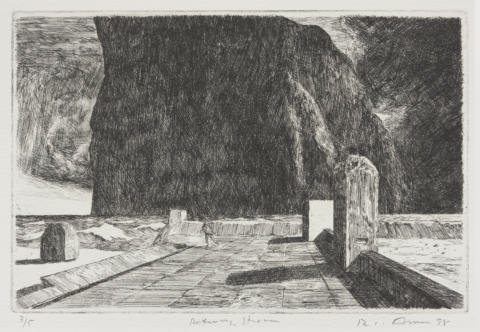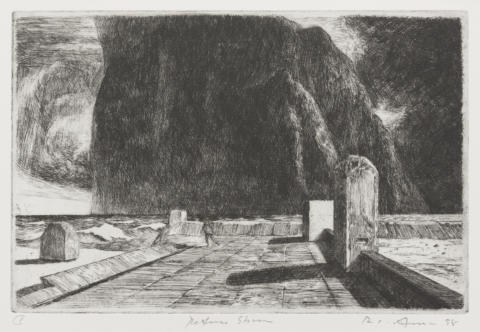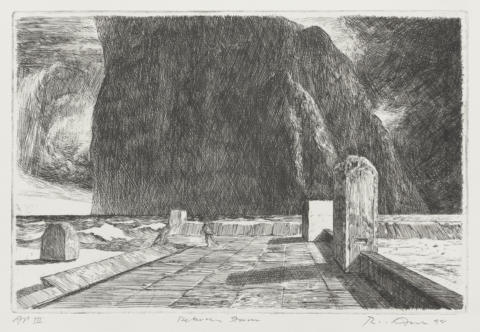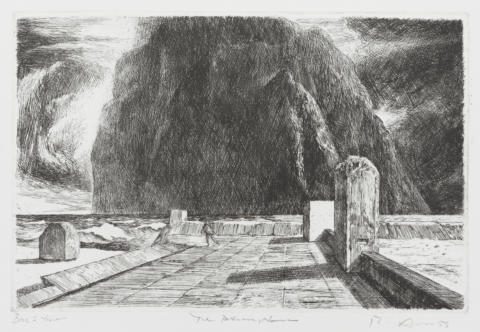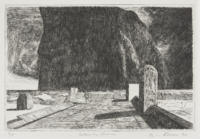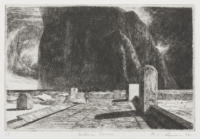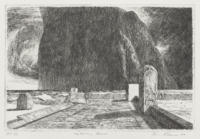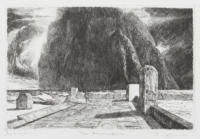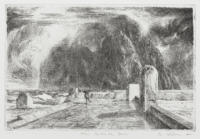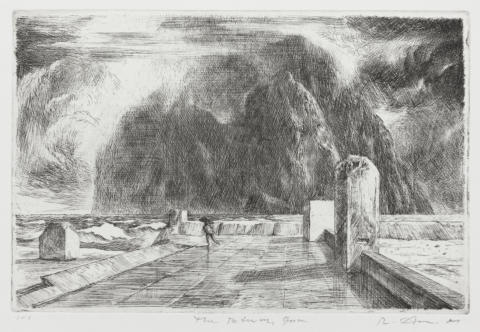
Etching. A great island monolith, its peak tilting left, looms close to shore. A man with an open umbrella runs diagonally leftwards along a low-lying pavement towards the choppy sea. The clouds in the left background are irregularly cross-hatched, while at the upper right, at the plate mark, dim light is created by lightly etched, near-horizontal parallel lines. There are four surviving variant impressions of this state. State proof 2/5 appears to have been destroyed by the artist.
The clouds at left have been selectively lightened with a burnisher. The hump on the rock at the upper right corner has been burnished to create a pointier shape and is now clearly back-lit; the corresponding area of light beside it has been made brighter. The pillar in the right foreground has been partly burnished, as has the pillar behind it. There are two variant impressions of this state.
More selective burnishing has been applied to the clouds at left, creating a distinct area of illumination. A strip of light has been burnished between the shadows of the two concrete pillars at right.
The rock’s upper left peak has been burnished away, creating a more rounded appearance. The clouds at the left and upper right are burnished in places, especially at the left, to admit more light, thereby creating the appearance of strong illumination behind the rock. The rock itself has been selectively burnished so as to give it a more varied surface and a bulkier appearance. The shadowed planes of the two pillars at right have been made lighter and the central pavement has also been lightened, while the shadow cast by the closest pillar has been narrowed. The sea at the juncture of the upper left corner of the pavements and the water is burnished to create the appearance of a trough.
On 17–18 May 2001 Amor reworked the plate extensively with a burnisher. As a result, the morphology of the rock has become increasingly irregular, with several distinct peaks evident; its top is now shrouded in mist. Additional billows have been etched into the clouds at the left and the upper right. The front plane of the large pillar at right and the stumpy broken pillar at left are now considerably lighter. Scattered vertical hatching on the concrete pavement suggests reflections in a wet surface. Etched shading has been introduced to the row of facing rocks at the pavement’s end. The running man and his umbrella have been darkened.
- Catalogue Number
- E.116
- Title and Date
- The returning storm
1998; reworked 1999 and 2001
- Description of Featured Image
- A great monolith looms close to shore as a storm encroaches, while a man holding an umbrella runs along a pavement towards the choppy sea.
- Medium Category and Technique
- Intaglio Print: Etching and burnishing on copper
- Support
- Wove paper. Identified papers: Saunders Waterford paper with watermark: ‘SAUNDERS WATERFORD’; Magnani Acqueforti paper with watermark: Romanesque ‘M’ with cross above; BFK Rives paper; Arches 88 paper with watermark: ‘ARCHES 88 / FRANCE’ with infinity symbol.
- Dimensions
-
Image size: 215 x 324 mm
Matrix size: 225 x 329 mm - Artist’s Record Number
- RAE.128 (1998), RAE.134 (1999), RAE.138 (2001)
- Printer(s) and Workshop(s)
- All state impressions, and first and second editions, printed by Rick Amor in his Alphington studio. Third edition printed by Martin King at the Australian Print Workshop, Fitzroy (Melbourne).
- Summary Edition Information
- Five states. Three editions. First edition: nominal edition of ten, but only four impressions printed and numbered, 1998. Second edition: nominal edition of ten, but only six impressions printed and numbered, 1999. Third edition: edition of ten numbered impressions, 2001.
- Exhibitions
- Niagara Galleries 1999: Niagara Galleries, Richmond (Melbourne), Rick Amor Sculpture, 2–27 March 1999, no. 2, ed. 1/10, 1998.
- National Gallery of Australia 2004: National Gallery of Australia, Canberra, Place Made: Australian Print Workshop, 31 January – 11 April 2004 [catalogue not numbered], APW workshop proof 2/2, 2001.
- Heide MoMA 2008: Heide Museum of Modern Art, Bulleen (Melbourne), Rick Amor: A Single Mind, 22 March – 13 July 2008, Prints no. 11, ed. 6/10, 2001.
- Australian Print Workshop 2014: Australian Print Workshop, Fitzroy (Melbourne), APW George Collie Memorial Award Exhibition: Rick Amor + Noel Counihan, 30 August – 4 October 2014, no. 10 (as not for sale).
- Literature
- For an illustration of the painting The visitor (The rock), 1994, see Robert Lindsay, Rick Amor: Standing in the Shadows (exh. cat.), McClelland Gallery and Sculpture Park, Langwarrin, Victoria, 2005, cat. no. 37, p. 49.
- Gavin Fry, Rick Amor, Beagle Press, Roseville, NSW, 2008, AP, 1999, p. 206 (where the date in the caption is incorrectly given as 1998). For an illustration of the painting Returning storm, 2001, see p. 125.
- Linda Short (ed.), Rick Amor: A Single Mind (exh. cat.), Heide Museum of Modern Art, Bulleen, Victoria, 2008, cat. no. 11, ed. 6/10, 2001, illus. p. 122.
- Bridget Macleod, ‘Rick Amor [interview]’, Artist Profile, no. 39, 2017, p. 82, pl. 05 (2001).
- Collections
- State Library of Victoria, Melbourne: nine state impressions, numbered 1, 1/3 through 3/3, 1/2, 2/5 through 5/5, all dated 1998; AP III, dated 1998; ed. 3/10, dated 1998; bon à tirer impression, dated 1999; one state impression, numbered 1-1, dated 2001.
- Art Gallery of South Australia, Adelaide: ed. 7/10, dated 2001 (20155G153).
- National Gallery of Australia, Canberra: ed. 4/10, dated 1998 (2007.666); ed. 2/10, with plate tone, dated 1999 (2007.355); APW workshop proof 2/2, dated 2001 (2002.431.846).
- National Gallery of Victoria, Melbourne: ed. 10/10, dated 2001 (2012.415).
- Comment
The image in E.116 originated in an oil painting made in 1994, The visitor (The rock) (Lindsay 2005), whose subject Amor adapted, with important changes of detail, to the smaller, horizontal format of the etching plate. A significant difference between the oil and the print was the substitution in the latter of a running figure for the stationary figure in the painting.
The huge monolith in the image reverberates with echoes of what, for Amor, are the ‘mythical’ Aran Islands, which lie off the west coast of Ireland, while also recalling Goya’s dark paintings and Arnold Böcklin’s depictions of the ‘Isle of the Dead’. The monolith is imagined, but the paved area is based on a section of the site in Melbourne’s CBD that was once occupied by the 1960s Gas and Fuel Buildings (demolished 1997), which stood where Federation Square stands today.
The first edition of the print is closest to the 1994 painting, but the etching progressively diverged from its model until, following the third edition, of 2001, E.116 itself became the model for a new painting, Returning storm, 2001 (Fry 2008).
The notion of some large, mysterious object or creature rising from the sea is deeply embedded in Amor’s psyche. A sense of unease and unreality is present in all three editions of this etching, but, as the morphology of the monolith changed through the print’s five states, and with it the weather, the island changed its character, seeming to grow in mystery and taking on a more otherworldly appearance. As indicated above, a crucial detail in the etching is the figure of the running man, whose reason for running cannot be known. His open umbrella, however, provides the grand scene with a curiously quotidian note.
As with all of Amor’s etchings, the mood and emotional tenor of E.116 can vary dramatically from one impression to the next, depending on how the plate was inked and wiped.
- Keywords
- Running man, Sea, Storm
- URL
- https://catalogue.rickamor.com.au/works/intaglio/the-returning-storm/
Record last updated 16/02/2021
